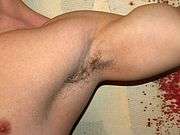Underarm hair
Underarm hair, also known as axillary hair, is the hair in the underarm area (axilla).
| Underarm hair | |
|---|---|
| Details | |
| Identifiers | |
| Latin | hirci |
| TA | A16.0.00.021 |
| FMA | 70756 |
| Anatomical terminology | |
Development and function
Underarm hair, as human body hair, normally starts to appear at the beginning of puberty, with growth usually completed by the end of the teenage years.

Axillary hair goes through 4 stages of development, driven by weak androgens produced by the adrenal in males and females during adrenarche, and testosterone from the testicle in males during puberty.[1] Like Tanner Staging for pubic hair, axillary hair can be staged according to the staging system, named for pediatric endocrinologist Joseph Wolfsdorf, as follows[2]:
- Wolfsdorf Stage 1- no axillary hair
- Wolfsdorf Stage 2- scant axillary hair (usually coinciding with onset of adrenarche)
- Wolfsdorf Stage 3- coarse axillary hair, less than full-adult
- Wolfsdorf Stage 4- full adult axillary hair
Staging a patient's axillary hair will allow the physician to track the child's development longitudinally.
The evolutionary significance of human underarm hair is still debated. It may naturally wick sweat or other moisture away from the skin, aiding ventilation. Colonization by odor-producing bacteria is thereby transferred away from the skin (see skin flora).[3] Overall, the main key feature armpit hair provides is to ease from skin-skin friction, and thus irritation, as the armpit when in its natural position and used in its natural function is constantly exposed to itself and the natural rubbing against itself a normal human put themselves through on a daily basis, even more so if they are doing any sort of physical labor, be it leisure or intense. And as stated previously, air ventilation and oil dispersion go hand-in-hand with this natural phenomenon.
 Male axilla
Male axilla- Female axilla
Cultural attitudes
Today in much of the Western world, it is common for women to regularly shave their underarm hair. Older generations of men typically do not trim or shave the underarm, but the practice has increased among younger men. A recent study found that 9% of 45-60 year old American men groom their underarms, while 73% of 15-20 year old American men either trim or shave their underarms.[4] The prevalence of this practice varies widely, though. Religious reasons are sometimes cited; for example, some in Islamic culture, both men and women remove underarm hair to meet religious guidelines of cleanliness. Removal of underarm hair was part of a collection of hygienic or cosmetic practices recommended by Muhammad (570-632) as consistent with fitra for both women and men and has since usually been regarded as a requirement by most Muslims.[5] In much of the Western world, some men also choose to remove their underarm hair for aesthetic reasons.
Many competitive swimmers remove nearly all of their body hair, including their underarm hair, believing it makes their bodies more streamlined during races. Many male bodybuilders and professional wrestlers also remove their body hair for cosmetic purposes.
Seneca the Younger suggests it was common practice in ancient Rome: "One is, I believe, as faulty as the other: the one class are unreasonably elaborate, the other are unreasonably negligent; the former depilate the leg, the latter not even the underarm." (letter 114).
In the West, the practice began for cosmetic reasons around 1915 in the United States and United Kingdom, when one or more magazines showed a woman in a dress with shaved underarms. Regular shaving became feasible with the introduction of the safety razor at the beginning of the 20th century. While underarm shaving was quickly adopted in some English-speaking countries, especially in the US and Canada, it did not become widespread in Europe until well after World War II.[6][7]
In art
In works of art, the underarm hair is usually removed; showing it is a mark of modernism. This contrasts to the depiction of pubic hair in art, which is rarely portrayed in works created in the Middle Ages, increasingly common in Renaissance art, and quite frequent in modern times.[8]
See also
| Wikimedia Commons has media related to Underarm hair. |
References
- Auchus, Richard J.; Rainey, William E. (1 March 2004). "Adrenarche - physiology, biochemistry and human disease". Clinical Endocrinology. 60 (3): 288–296. doi:10.1046/j.1365-2265.2003.01858.x. ISSN 0300-0664. PMID 15008992.
- "Joseph Wolfsdorf, MD, BCh | Boston Children's Hospital". www.childrenshospital.org. Retrieved 28 July 2019.
- Paye, Marc; Maibach, Howard I.; Barel, André O (2009). Handbook of cosmetic science and technology (3 ed.). Informa Health Care. p. 703. ISBN 1-4200-6963-2.
- "Shaving Tips". WebMD.
- "Compendium of Islamic Texts". USC. Archived from the original on 5 March 2012. Retrieved 24 March 2012.
- Hope, Christine (1982). "Caucasian Female Body Hair and American Culture". Journal of American Culture. 5 (1): 93–99. doi:10.1111/j.1542-734X.1982.0501_93.x.
- Adams, Cecil (6 February 1991). "Who decided women should shave their legs and underarms?". The Straight Dope. Retrieved 22 January 2015.
- Weekes, Ann Owens (1993). "Students' Self-Image: Representations of Women in "High" Art and Popular Culture". Woman's Art Journal. 13 (2): 32–38. doi:10.2307/1358151. JSTOR 1358151.